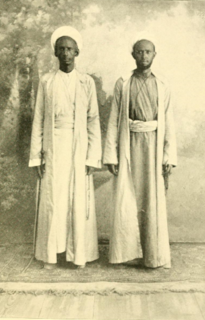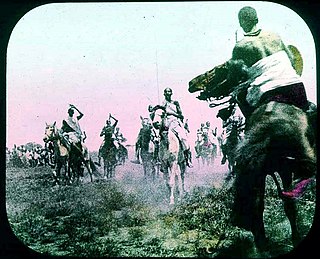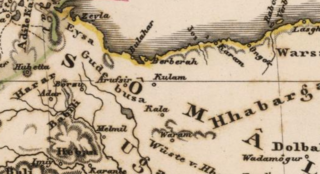Related Research Articles
The Habar Yoonis alternatively spelled as Habr Yunis is a major clan of the wider Garhajis clan of the Isaaq. As descendants of Ismail bin Sheikh Isaaq, its members form a part of the wider Habar Magaadle confederation, and they constitute the largest sub-clan of the Isaaq.

The Isaaq is a Somali clan. It is one of the major noble Somali clans in the Horn of Africa, with a large and densely populated traditional territory.
The Garhajis historically known as the Habar Gerhajis is a major clan of the wider Isaaq clan family. They are the traditional holders of the Isaaq Sultanate and Habr Yunis Sultanate since the 18th century. As descendants of Ismail bin Sheikh Isaaq, its members form a part of the Habar Magaadle confederation, and they constitute the largest sub-clan of the Isaaq. The Garhajis are divided into two major sub-clans: the Habr Yunis and Eidagale. They are traditionally nomadic pastoralists, merchants and skilled poets.

Sayid Mohamed Abdullahi Hassan was a Somali religious and military leader of the Dervish movement, which led a two-decade long confrontation with various colonial empires including the British, Italians, and Abyssinians.
The Habr Awal, also contemporarily known as the Subeer Awal, and alternately romanized as the Zubeyr Awal is a major clan of the wider Isaaq clan family, and is further divided into eight sub-clans of whom the two largest and most prominent are the Sa'ad Musa and Issa Musa sub-clans. Its members form a part of the Habr Magaadle confederation. The Habr Awal traditionally consists of nomadic pastoralists, coastal people, merchants and farmers. They are historically viewed as an affluent clan relative to other Somali clans. The Habr Awal are politically and economically influential in present-day Somaliland, and reside in strategic coastal and fertile lands.

Taleh is a historical town in the eastern Sool region of Somaliland. As of September 2015, both Puntland and Somaliland had nominal influence or control in Taleh and it's vicinity. The town served as the capital of the pre-independence Dervish movement.
The Dervish movement was a popular movement between 1899 and 1920, which was led by the Salihiyya Sufi Muslim poet and militant leader Mohammed Abdullah Hassan, also known as Sayyid Mohamed, who called for independence from the British and Italian colonies and the defeat of Ethiopian forces. The Dervish movement aimed to remove the British and Italian influence from the region and restore the "Islamic system of government with Islamic education as its foundation", according to Mohamed-Rahis Hasan and Salada Robleh.

Ahmed Warsama, more commonly known as Haji Sudi was one of the leaders behind the Somali Dervish movement. He was also the movement's right-hand man and chief lieutenant till its demise in 1920. He is described as the Mullah's right hand in the earlier days of his rise. He hailed from the Adan Madoba sub-clan of the Habr Je'lo clan.

SultanNur Ahmed Aman, was a learned religious leader and the 5th Sultan of the Habr Yunis Sultanate and later also one of the leaders behind the Somali Dervish movement and revolt (1899–1920). He was the principal agitator rallying the followers of the Kob Fardod Tariqa behind his anti-French Roman Catholic Mission campaign that would become the cause of the Dervish uprising. He assisted in assembling men and arms and hosted the revolting tribesmen in his quarter at Burao in August 1899, declaring the Dervish rebellion. He fought and led the war throughout the years 1899–1904. He and his brother Geleh Ahmed were the main signatories of the Dervish peace treaty with the British, Ethiopians and Italian colonial powers on March 5, 1905, known as the Ilig Treaty or the Pestalozza agreement. Sultan Nur is entombed in a white-domed shrine in Taleh, the location of the largest Dervish forts and the capital of the Dervish from 1912 to 1920, a testimony to his contribution in creating the movement.
The Habr Je'lo (Somali: Habar Jeclo, Arabic: هبر جعلو, Full Name: Mūsa ibn ash-Shaykh Isḥāq ibn Aḥmad, historically known as the Habr Toljaala is a major subtribe of the wider Isaaq tribe-family. Its members form part of the Habr Habushed confederation along with the Ibran, Sanbuur and Tolje’lo.
Ibrahim Hassan Boghol was a Somali military leader. He was a member of the Dervish council, called the Khusuusi, and was also the commander of the northern Dervish army. He was among the most wanted Dervish leaders in British Somaliland. Ibrahim Boghol hailed from the Adan Madobe sub-division of the Habr Je'lo clan of the Isaaq clan family.
Sultan Deria Hassan was a Somali ruler. He was the fourth Grand Sultan of the Isaaq Sultanate and known as a shrewd and wise leader.
The Mohamed Abokor is a Somali clan, and a major sub-division of the Habr Je'lo clan of the Isaaq.
The Musa Abokor is a Somali clan, and a 2 major sub-division of the Habr Je'lo clan of the Isaaq clan-family.
Sultan Madar Hersi Deria was a Somali ruler and the 7th Sultan of the Habr Yunis Sultanate.

The Isaaq Sultanate was a Somali kingdom that ruled parts of the Horn of Africa during the 18th and 19th centuries. It spanned the territories of the Isaaq clan in modern day Somaliland and Ethiopia. The sultanate was governed by the Rer Guled branch of the Eidagale clan and is the pre-colonial predecessor to the modern Republic of Somaliland.

The Habr Yunis Sultanate was a Somali kingdom that ruled parts of the Horn of Africa during the 18th century. It spanned the territories of the Habr Yunis clan which is part of the wider Isaaq in modern day Somaliland and Ethiopia. The sultanate was governed by the Rer Ainanshe branch of the Habr Yunis clan.
The Rer Ainanshe are a royal Somali clan and the traditional rulers of the Habr Yunis. They divide into 17 major sub-clans that together form the Baha Ainanshe and Rer Sugulle, from the latter descend the rulers of the Habr Yunis Sultanate. They inhabit the Togdheer and Maroodi Jeex regions of Somaliland and the Daroor and Misraq Gashamo regions of Ethiopia

Abdallah Mohamed Shihiri was a senior Khusuusi member of the Somali Dervish movement and was part of the movement since its inception. He was long time companion and a childhood friend of Mohamed Abdullah Hassan and notable weapons smuggler. He belonged to the Adan Madoba sub-clan of the Habr Je'lo clan of the Isaaq clan family.
References
- ↑ Haji, Abdiwahid Osman (2001). Somalia: A Chronology of Historical Documents 1827-2000. A. Osman Haji. ISBN 978-0-9688743-0-1.
- ↑ Ministero della Guerra, Comando del Corpo di S.M./Ufficio Storico: SOMALIA, Vol. I, Dalle Original 1914, Roma, 1938- XVI, pp. 308, 309, 315, 318, 319.
- ↑ Caroselli, op. cit. 78-9.
- ↑ Official history of the operations in Somaliland, 1901–04 by Great Britain. War Office. General Staff Published 1907.p.56
- ↑ Imperialismo e resistenza in corno d'Africa: Mohammed Abdullah Hassan e il derviscismo somalo (1899-1920)p.198
- ↑ Caroselli, Francesco Saverio (1931). "Ferro e fuoco in Somalia".
- ↑ Official History of the Operations in Somaliland. 1901–1904 Vol. I p. 54
- ↑ Ministero della Guerra, Comando del Corpo di S.M./Ufficio Storico: SOMALIA, Vol. I, Dalle Original 1914, Roma, 1938- XVI, pp. 308, 309, 315, 318, 319.